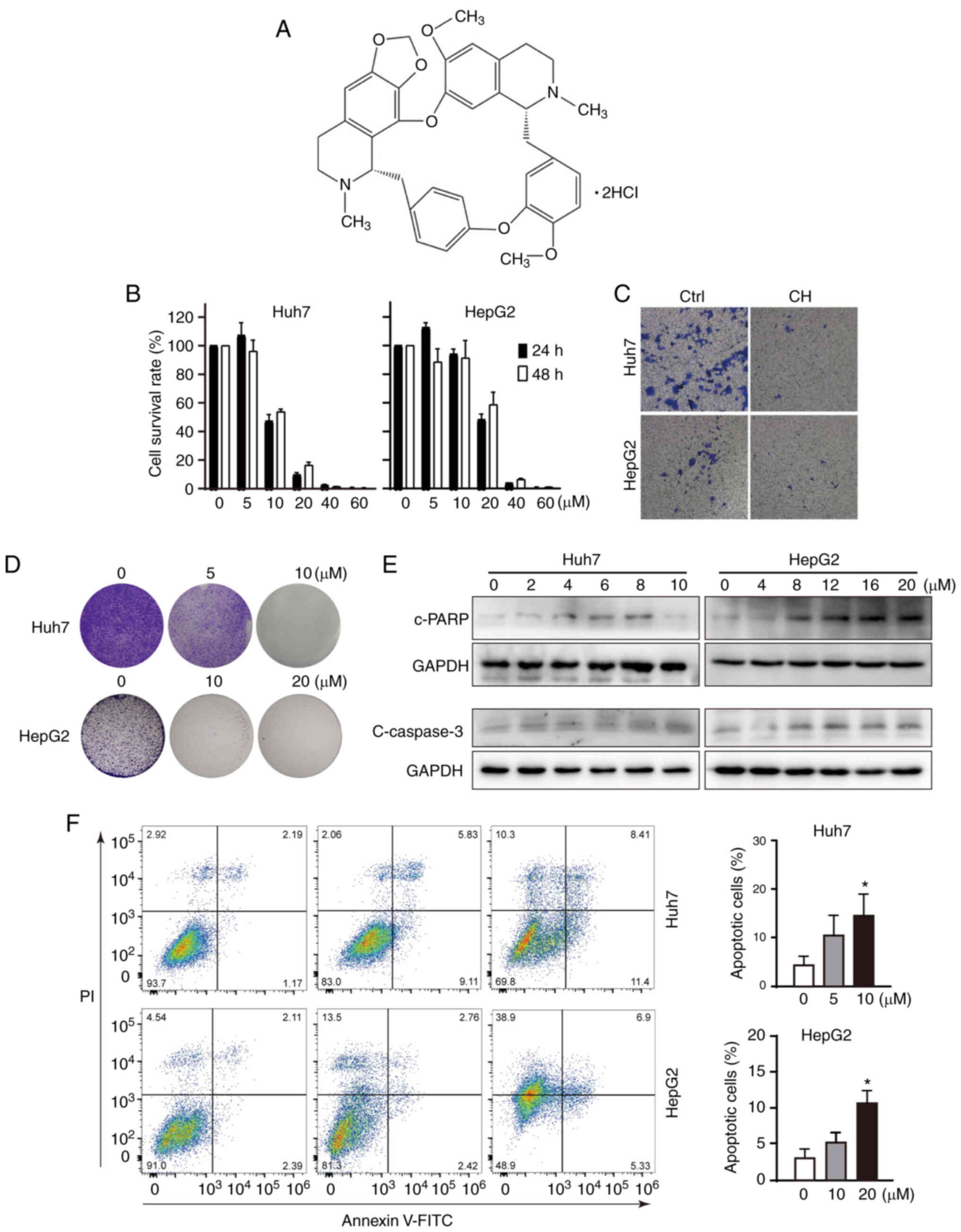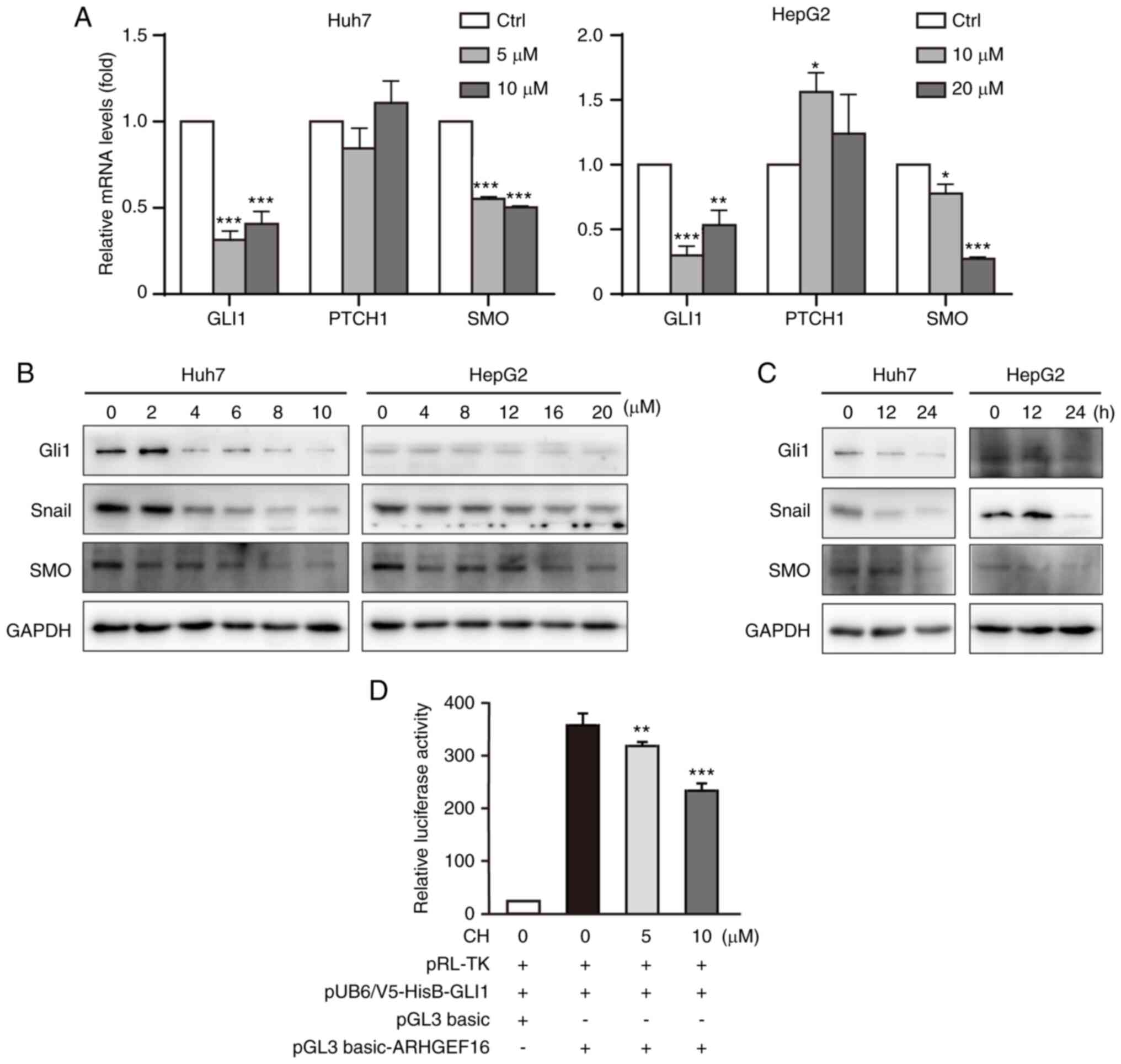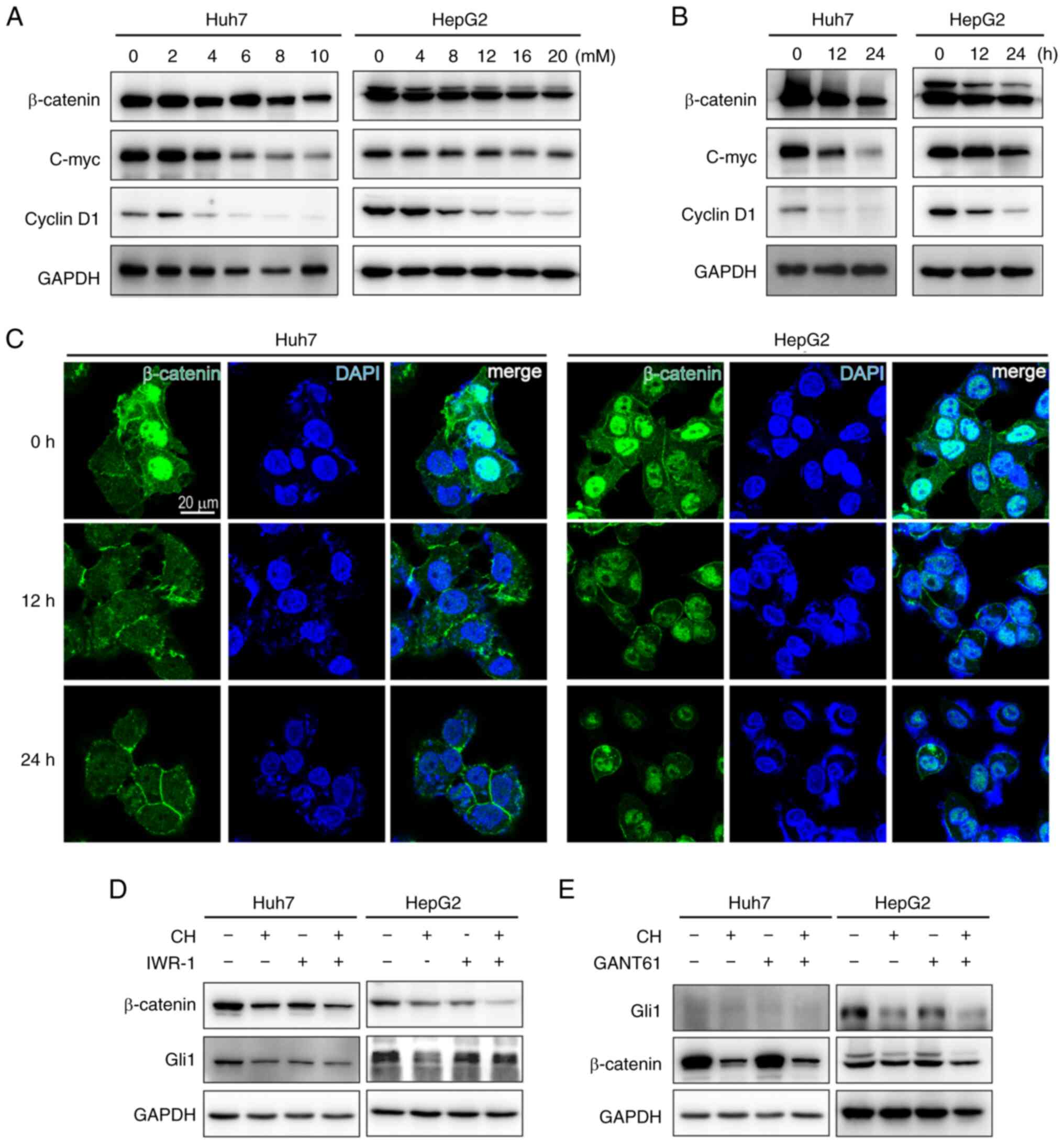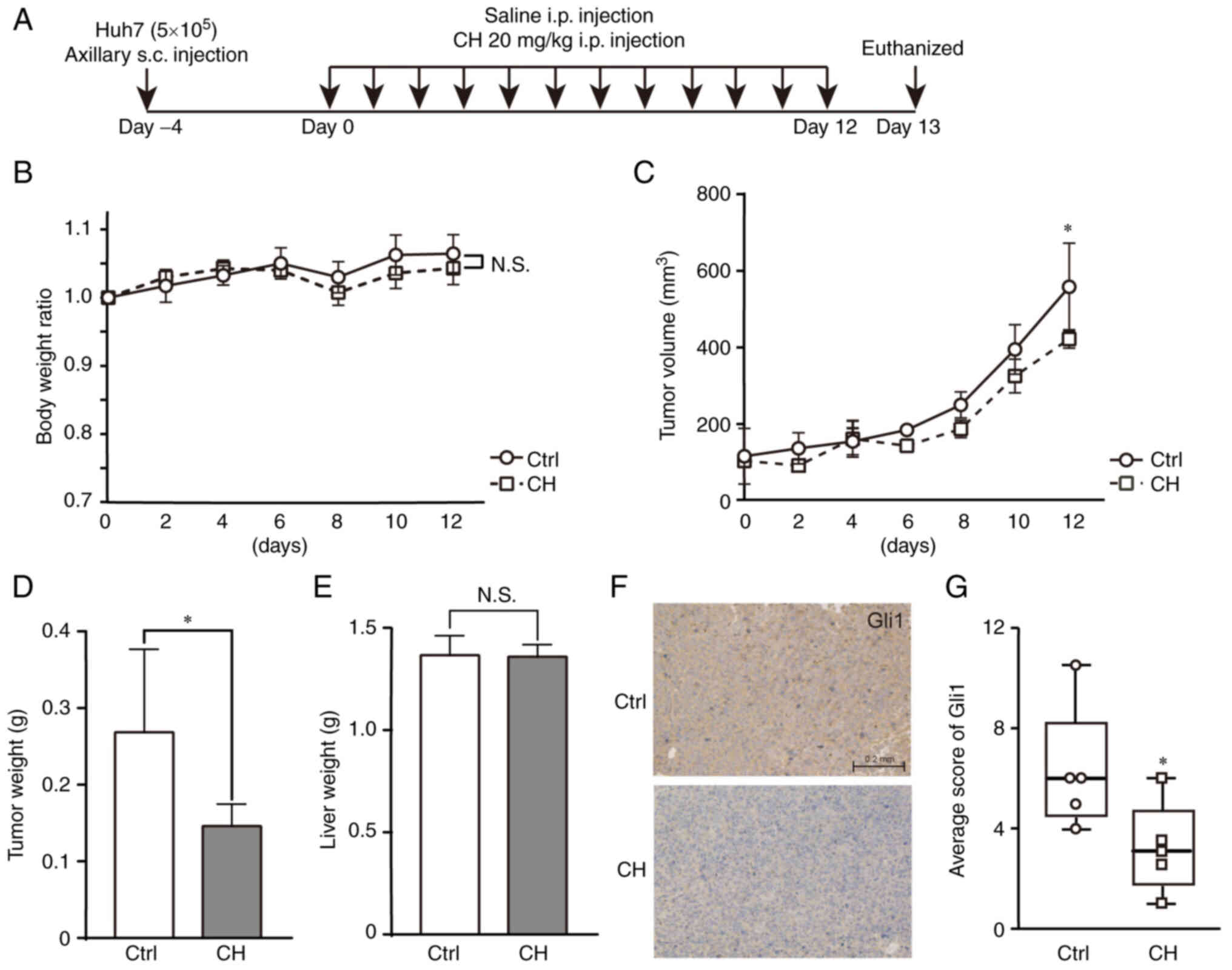|
1
|
Siegel RL, Miller KD and Jemal A: Cancer
statistics, 2018. CA Cancer J Clin. 68:7–30. 2018. View Article : Google Scholar : PubMed/NCBI
|
|
2
|
Daher S, Massarwa M, Benson AA and Khoury
T: Current and future treatment of hepatocellular carcinoma: An
updated comprehensive review. J Clin Transl Hepatol. 6:69–78. 2018.
View Article : Google Scholar : PubMed/NCBI
|
|
3
|
Nishida N, Kitano M, Sakurai T and Kudo M:
Molecular mechanism and prediction of sorafenib chemoresistance in
human hepatocellular carcinoma. Dig Dis. 33:771–779. 2015.
View Article : Google Scholar : PubMed/NCBI
|
|
4
|
Niu L, Liu L, Yang S, Ren J, Lai PBS and
Chen GG: New insights into sorafenib resistance in hepatocellular
carcinoma: Responsible mechanisms and promising strategies. Biochim
Biophys Acta Rev Cancer. 1868:564–570. 2017. View Article : Google Scholar : PubMed/NCBI
|
|
5
|
Della Corte CM, Viscardi G, Papaccio F,
Esposito G, Martini G, Ciardiello D, Martinelli E, Ciardiello F and
Morgillo F: Implication of the Hedgehog pathway in hepatocellular
carcinoma. World J Gastroenterol. 23:4330–4340. 2017. View Article : Google Scholar : PubMed/NCBI
|
|
6
|
Che L, Yuan YH, Jia J and Ren J:
Activation of sonic hedgehog signaling pathway is an independent
potential prognosis predictor in human hepatocellular carcinoma
patients. Chin J Cancer Res. 24:323–331. 2012. View Article : Google Scholar : PubMed/NCBI
|
|
7
|
Katoh Y and Katoh M: Hedgehog target
genes: Mechanisms of carcinogenesis induced by aberrant hedgehog
signaling activation. Curr Mol Med. 9:873–886. 2009. View Article : Google Scholar : PubMed/NCBI
|
|
8
|
Huang D, Wang Y, Xu L, Chen L, Cheng M,
Shi W, Xiong H, Zalli D and Luo S: GLI2 promotes cell proliferation
and migration through transcriptional activation of ARHGEF16 in
human glioma cells. J Exp Clin Cancer Res. 37:2472018. View Article : Google Scholar : PubMed/NCBI
|
|
9
|
Mayank .Jaitak V: Molecular docking study
of natural alkaloids as multi-targeted hedgehog pathway inhibitors
in cancer stem cell therapy. Comput Biol Chem. 62:145–154. 2016.
View Article : Google Scholar : PubMed/NCBI
|
|
10
|
Drenkhahn SK, Jackson GA, Slusarz A,
Starkey NJ and Lubahn DB: Inhibition of hedgehog/Gli signaling by
botanicals: A review of compounds with potential hedgehog pathway
inhibitory activities. Curr Cancer Drug Targets. 13:580–595. 2013.
View Article : Google Scholar : PubMed/NCBI
|
|
11
|
Wang J, Peng Y, Liu Y, Yang J, Ding N and
Tan W: Berberine, a natural compound, suppresses Hedgehog signaling
pathway activity and cancer growth. BMC Cancer. 15:5952015.
View Article : Google Scholar : PubMed/NCBI
|
|
12
|
Chen JK, Taipale J, Cooper MK and Beachy
PA: Inhibition of Hedgehog signaling by direct binding of
cyclopamine to Smoothened. Genes Dev. 16:2743–2748. 2002.
View Article : Google Scholar : PubMed/NCBI
|
|
13
|
Bijlsma MF, Peppelenbosch MP and Spek CA:
(Pro-)vitamin D as treatment option for hedgehog-related
malignancies. Med Hypotheses. 70:202–203. 2008. View Article : Google Scholar : PubMed/NCBI
|
|
14
|
Infante P, Mori M, Alfonsi R, Ghirga F,
Aiello F, Toscano S, Ingallina C, Siler M, Cucchi D, Po A, et al:
Gli1/DNA interaction is a druggable target for Hedgehog-dependent
tumors. EMBO J. 34:200–217. 2015. View Article : Google Scholar : PubMed/NCBI
|
|
15
|
Bao C, Kramata P, Lee HJ and Suh N:
Regulation of hedgehog signaling in cancer by natural and dietary
compounds. Mol Nutr Food Res. 62:2018.doi: 10.1002/mnfr.201700621.
View Article : Google Scholar
|
|
16
|
Rogosnitzky M and Danks R: Therapeutic
potential of the biscoclaurine alkaloid, cepharanthine, for a range
of clinical conditions. Pharmacol Rep. 63:337–347. 2011. View Article : Google Scholar : PubMed/NCBI
|
|
17
|
Zhou P, Zhang R, Wang Y, Xu D, Zhang L,
Qin J, Su G, Feng Y, Chen H, You S, et al: Cepharanthine
hydrochloride reverses the mdr1 (P-glycoprotein)-mediated
esophageal squamous cell carcinoma cell cisplatin resistance
through JNK and p53 signals. Oncotarget. 8:111144–111160. 2017.
View Article : Google Scholar : PubMed/NCBI
|
|
18
|
Tang ZH, Cao WX, Guo X, Dai XY, Lu JH,
Chen X, Zhu H and Lu JJ: Identification of a novel autophagic
inhibitor cepharanthine to enhance the anti-cancer property of
dacomitinib in non-small cell lung cancer. Cancer Lett. 412:1–9.
2017. View Article : Google Scholar : PubMed/NCBI
|
|
19
|
Gao S, Li X, Ding X, Qi W and Yang Q:
Cepharanthine induces autophagy, apoptosis and cell cycle arrest in
breast cancer cells. Cell Physiol Biochem. 41:1633–1648. 2017.
View Article : Google Scholar : PubMed/NCBI
|
|
20
|
Harada K, Ferdous T, Itashiki Y, Takii M,
Mano T, Mori Y and Ueyama Y: Cepharanthine inhibits angiogenesis
and tumorigenicity of human oral squamous cell carcinoma cells by
suppressing expression of vascular endothelial growth factor and
interleukin-8. Int J Oncol. 35:1025–1035. 2009. View Article : Google Scholar : PubMed/NCBI
|
|
21
|
Seubwai W, Vaeteewoottacharn K, Hiyoshi M,
Suzu S, Puapairoj A, Wongkham C, Okada S and Wongkham S:
Cepharanthine exerts antitumor activity on cholangiocarcinoma by
inhibiting NF-kappaB. Cancer Sci. 101:1590–1595. 2010. View Article : Google Scholar : PubMed/NCBI
|
|
22
|
Bailly C: Cepharanthine: An update of its
mode of action, pharmacological properties and medical
applications. Phytomedicine. 62:1529562019. View Article : Google Scholar : PubMed/NCBI
|
|
23
|
Tamatani T, Azuma M, Motegi K, Takamaru N,
Kawashima Y and Bando T: Cepharanthin-enhanced radiosensitivity
through the inhibition of radiation-induced nuclear factor-kappa B
activity in human oral squamous cell carcinoma cells. Int J Oncol.
31:761–768. 2007.PubMed/NCBI
|
|
24
|
Biswas KK, Tancharoen S, Sarker KP,
Kawahara K, Hashiguchi T and Maruyama I: Cepharanthine triggers
apoptosis in a human hepatocellular carcinoma cell line (HuH-7)
through the activation of JNK1/2 and the downregulation of Akt.
FEBS Lett. 580:703–710. 2006. View Article : Google Scholar : PubMed/NCBI
|
|
25
|
Rattanawong A, Payon V, Limpanasittikul W,
Boonkrai C, Mutirangura A and Wonganan P: Cepharanthine exhibits a
potent anticancer activity in p53-mutated colorectal cancer cells
through upregulation of p21Waf1/Cip1. Oncol Rep. 39:227–238.
2018.PubMed/NCBI
|
|
26
|
Hua P, Sun M, Zhang G, Zhang Y, Tian X, Li
X, Cui R and Zhang X: Cepharanthine induces apoptosis through
reactive oxygen species and mitochondrial dysfunction in human
non-small-cell lung cancer cells. Biochem Biophys Res Commun.
460:136–142. 2015. View Article : Google Scholar : PubMed/NCBI
|
|
27
|
Shi C, Huang D, Lu N, Chen D, Zhang M, Yan
Y, Deng L, Lu Q, Lu H and Luo S: Aberrantly activated Gli2-KIF20A
axis is crucial for growth of hepatocellular carcinoma and predicts
poor prognosis. Oncotarget. 7:26206–26219. 2016. View Article : Google Scholar : PubMed/NCBI
|
|
28
|
Xin M, Ji X, De La Cruz LK, Thareja S and
Wang B: Strategies to target the Hedgehog signaling pathway for
cancer therapy. Med Res Rev. 38:870–913. 2018. View Article : Google Scholar : PubMed/NCBI
|
|
29
|
Onishi H and Katano M: Hedgehog signaling
pathway as a therapeutic target in various types of cancer. Cancer
Sci. 102:1756–1760. 2011. View Article : Google Scholar : PubMed/NCBI
|
|
30
|
Girardi D, Barrichello A, Fernandes G and
Pereira A: Targeting the hedgehog pathway in cancer: Current
evidence and future perspectives. Cells. 8:1532019. View Article : Google Scholar : PubMed/NCBI
|
|
31
|
Infante P, Alfonsi R, Botta B, Mori M and
Di Marcotullio L: Targeting GLI factors to inhibit the Hedgehog
pathway. Trends Pharmacol Sci. 36:547–558. 2015. View Article : Google Scholar : PubMed/NCBI
|
|
32
|
Wang ZY and Chen Z: Differentiation and
apoptosis induction therapy in acute promyelocytic leukaemia.
Lancet Oncol. 1:101–106. 2000. View Article : Google Scholar : PubMed/NCBI
|
|
33
|
Lv XH, Wang CH and Xie Y: Arsenic trioxide
combined with transarterial chemoembolization for primary liver
cancer: A meta-analysis. J Gastroenterol Hepatol. 32:1540–1547.
2017. View Article : Google Scholar : PubMed/NCBI
|
|
34
|
Owonikoko TK, Zhang G, Kim HS, Stinson RM,
Bechara R, Zhang C, Chen Z, Saba NF, Pakkala S, Pillai R, et al:
Patient-derived xenografts faithfully replicated clinical outcome
in a phase II co-clinical trial of arsenic trioxide in relapsed
small cell lung cancer. J Transl Med. 14:1112016. View Article : Google Scholar : PubMed/NCBI
|
|
35
|
Song Z, Wei B, Lu C, Huang X, Li P and
Chen L: Metformin suppresses the expression of Sonic hedgehog in
gastric cancer cells. Mol Med Rep. 15:1909–1915. 2017. View Article : Google Scholar : PubMed/NCBI
|
|
36
|
Fan C, Wang Y, Liu Z, Sun Y, Wang X, Wei G
and Wei J: Metformin exerts anticancer effects through the
inhibition of the Sonic hedgehog signaling pathway in breast
cancer. Int J Mol Med. 36:204–214. 2015. View Article : Google Scholar : PubMed/NCBI
|
|
37
|
Nakamura M, Ogo A, Yamura M, Yamaguchi Y
and Nakashima H: Metformin suppresses sonic hedgehog expression in
pancreatic cancer cells. Anticancer Res. 34:1765–1769.
2014.PubMed/NCBI
|
|
38
|
Chatterjee S and Sil PC: Targeting the
crosstalks of Wnt pathway with Hedgehog and Notch for cancer
therapy. Pharmacol Res. 142:251–261. 2019. View Article : Google Scholar : PubMed/NCBI
|
|
39
|
Ding M and Wang X: Antagonism between
Hedgehog and Wnt signaling pathways regulates tumorigenicity. Oncol
Lett. 14:6327–6333. 2017.PubMed/NCBI
|
|
40
|
Katoh Y and Katoh M: WNT antagonist,
SFRP1, is Hedgehog signaling target. Int J Mol Med. 17:171–175.
2006.PubMed/NCBI
|
|
41
|
Arnold KM, Pohlig RT and Sims-Mourtada J:
Co-activation of Hedgehog and Wnt signaling pathways is associated
with poor outcomes in triple negative breast cancer. Oncol Lett.
14:5285–5292. 2017.PubMed/NCBI
|
|
42
|
Anastas JN and Moon RT: WNT signalling
pathways as therapeutic targets in cancer. Nat Rev Cancer.
13:11–26. 2013. View Article : Google Scholar : PubMed/NCBI
|
|
43
|
Kikukawa Y, Okuno Y, Tatetsu H, Nakamura
M, Harada N, Ueno S, Kamizaki Y, Mitsuya H and Hata H: Induction of
cell cycle arrest and apoptosis in myeloma cells by cepharanthine,
a biscoclaurine alkaloid. Int J Oncol. 33:807–814. 2008.PubMed/NCBI
|
|
44
|
Lyu J, Yang EJ, Head SA, Ai N, Zhang B, Wu
C, Li RJ, Liu Y, Yang C, Dang Y, et al: Pharmacological blockade of
cholesterol trafficking by cepharanthine in endothelial cells
suppresses angiogenesis and tumor growth. Cancer Lett. 409:91–103.
2017. View Article : Google Scholar : PubMed/NCBI
|
|
45
|
Harada T, Harada K and Ueyama Y: The
enhancement of tumor radioresponse by combined treatment with
cepharanthine is accompanied by the inhibition of DNA damage repair
and the induction of apoptosis in oral squamous cell carcinoma. Int
J Oncol. 41:565–572. 2012. View Article : Google Scholar : PubMed/NCBI
|


















